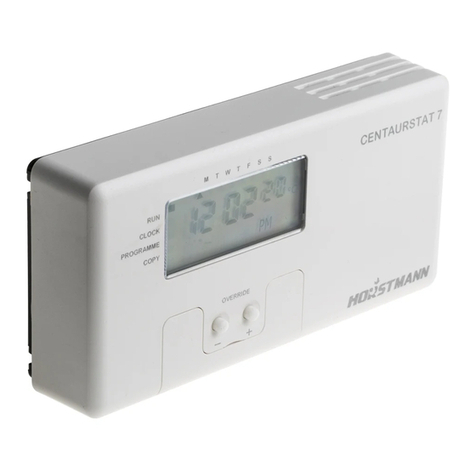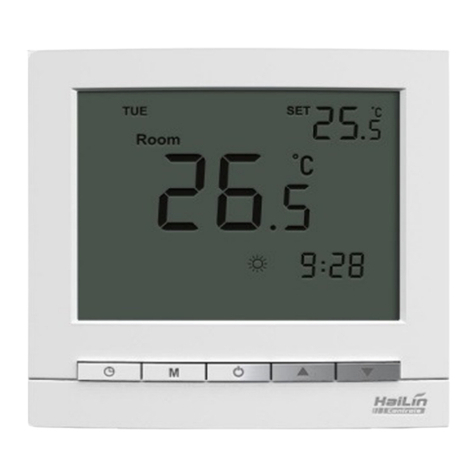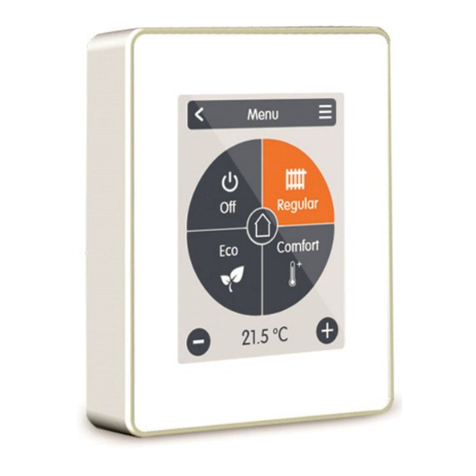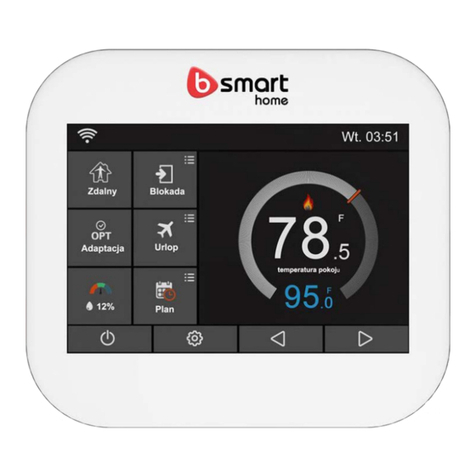Plum ecomaxx 800 R2 User manual

Boiler regulator
ecoMAXX 800, model R2
FOR SOLID FUEL BOILERS
A, B, C –functions chich are available in module, respectively: A, B, C
* room panel ecoSTER200 (module B, C and ecoSTER200 are not part of standard equipment)
SERVICE AND ASSEMBLY MANUAL
ISSUE: 1.3
SOFTWAREE:
MODULE
PANEL
v.01.XX.XX
v.01.XX.XX
2013-09-13


PRINCIPLES FOR USAGE OF Individual Fuzzy Logic
CONTROLLED BOILER:
The regulator must be programmed individually for the given
type of boiler and fuel, p. 21.1!
It is inadmissible to change the type of gear-motor, fan, and
to make other changes in the boiler fittings which can
influence the burning process. The fittings should correspond
to the components installed by the manufacturer, p. 21!
It is recommended to operate boiler with maximally-opened
fan flap.
Activation of the fuzzy logic mode does not eliminate the
necessity of regulating the SUPERVISION parameters, p. 7.9.
In some cases, the fuzzy logic mode may require additional
adjustment, as per p. 7.8.

TABLE OF CONTENTS
1RECOMMENDATIONS REGARDING SAFETY............... 5
2GENERAL INFORMATION .......................................... 6
3INFORMATION ABOUT DOCUMENTATION ............... 6
4STORAGE OF DOCUMENTATION ............................... 6
5APPLIED SYMBOLS..................................................... 6
6DIRECTIVE WEEE 2002/96/EG ................................... 6
REGULATOR INSTRUCTION MANUAL ............ 7
7OPERATING THE REGULATOR ................................... 8
7.1 BUTTONS DESCRIPTION ........................................... 8
7.2 MAIN DISPLAY WINDOW DESCRIPTION ....................... 8
7.3 REGULATOR START-UP ............................................ 9
7.4 SETTING THE PRESET BOILER TEMPERATURE................. 9
7.5 STOP.................................................................. 9
7.6 FIRING UP.......................................................... 9
7.7 OPERATION –STANDARD MODE...................... 10
7.8 OPERATION–FUZZY LOGIC MODE ........................ 11
7.9 SUPERVISION .................................................. 11
7.10 SELECTION OF FUEL .............................................. 12
7.11 HUW SETTINGS .................................................. 12
7.12 SETTING THE PRESET HUW TEMPERATURE ............... 12
7.13 ACTIVATION OF SUMMER FUNCTION..................... 12
7.14 DISINFECTION OF HUW CONTAINER........................ 13
7.15 MIXER CIRCLE SETTINGS ........................................ 13
7.16 WEATHER CONTROL ............................................. 14
7.17 DESCRIPTION OF NIGHT TIME DECREASE SETTINGS...... 14
7.18 CONTROL OF HUW CIRCULATING PUMP................... 15
7.19 GRATE............................................................... 15
7.20 MANUAL CONTROL .............................................. 15
7.21 FUEL LEVEL CONFIGURATION .................................. 15
USER MANUAL OF CONTROLLER
INSTALLATION AND SERVICE SETTINGS....... 17
8HYDRAULIC DIAGRAMS ........................................... 18
8.1 DIAGRAM 1........................................................ 18
8.2 DIAGRAM 2........................................................ 19
8.3 DIAGRAM 3........................................................ 20
8.4 SCHEMAT 4 ........................................................ 21
9TECHNICAL DATA .................................................... 22
10 STORAGE AND TRANSPORT CONDITIONS ............... 22
11 REGULATOR INSTALLATION .................................... 22
11.1 ENVIRONMENTAL CONDITIONS ............................... 22
11.2 MOUNTING REQUIREMENTS .................................. 22
11.3 INSTALLATION OF CONTROL PANEL .......................... 22
11.4 MOUNTING OF OPERATING UNIT............................ 23
11.5 IP PROTECTION RATE.............................................24
11.6 ELECTRIC CONNECTION..........................................24
11.7 TEMPERATURE SENSORS CONNECTION......................27
11.8 WEATHER SENSORS CONNECTION ............................28
11.9 TESTING OF TEMPERATURE SENSORS ........................28
11.10 CONNECTION OF BOILER’S ROOM THERMOSTAT..........28
11.11 CONNECTION OF MIXER’S ROOM THERMOSTAT...........29
11.12 CONNECTION OF RESERVE BOILER ............................29
11.13 CONNECTION OF ALARM SIGNALLING........................31
11.14 CONNECTION OF MIXER SERVO................................31
11.15 CONNECTION OF MIXER PUMP ................................32
11.16 CONNECTION OF BOILER SHUNT PUMP......................32
11.17 CONNECTION OF TEMPERATURE LIMITER...................33
11.18 CONNECTION OF ROOM CONTROL PANEL ..................33
12 BOILER SERVICE SETTINGS.......................................35
13 SERVIS SETTINGS OF PUMPS ...................................36
14 SERVICE SETTINGS OF MIXER...................................38
15 BUFFER.....................................................................39
16 OUTPUT H ................................................................39
17 ALARM DESCRIPTION...............................................40
17.1 NO FUEL.............................................................40
17.2 MAX.BOILER TEMP.EXCESS ....................................40
17.3 EXCEEDING MAX.FEEDER TEMPERATURE...................40
17.4 FEEDER TEMP.SENSOR DAMAGED............................41
17.5 FEEDER TEMP SENSOR DAMAGED.............................41
17.6 NO COMMUNICATION ...........................................41
18 ADDITIONAL FUNCTIONS.........................................41
18.1 POWER SUPPLY DECAY...........................................41
18.2 PROTECTION AGAINST FREEZING..............................41
18.3 PREVENTIVE COOLING DOWN..................................41
18.4 PROTECTION OF PUMPS AGAINST LOCKING ................41
19 REPLACEMENT OF PARTS AND COMPONENTS........41
19.1 REPLACEMENT OF MAINS FUSE................................41
19.2 CONTROL PANEL REPLACEMENT...............................42
20 TROUBLESHOOTING ................................................43
21 REGULATOR SETTING BY BOILER MANUFACTURER.45
21.1 ACTIVATING INDIVIDUAL FUZZY LOGIC AND CHANGING
BOILER TYPE ..................................................................45
22 CHANGE RECORD.....................................................46

5
1RECOMMENDATIONS REGARDING
SAFETY
Requirements concerning safety
are described in detail in
individual chapters of this
manual. Apart from them, the
following requirements should
in particular be observed.
Before starting assembly,
repairs or maintenance, as well
as during any connection
works, please make sure that
the mains power supply is
disconnected and that terminals
and electric wires are devoid of
voltage.
After the regulator is turned off
using the keyboard, dangerous
voltage still can occur on its
terminals.
The regulator cannot be used at
variance with its purpose.
Additional automatics which
protect the boiler, central
heating (CH) system, and
domestic hot water system
against results of malfunction of
the regulator, or of errors in its
software, should be applied.
Choose the value of the
programmed parameters
accordingly to the given type of
boiler and fuel, taking into
consideration all the operational
conditions of the system.
Incorrect selection of the
parameters can cause
malfunction of the boiler (e.g.
overheating of the boiler, the
flame going back to the fuel
feeder, etc.),
The regulator is intended for
boiler manufacturers. Before
applying the regulator, a boiler
manufacturer should check if
the regulator’s mating with the
given boiler type is proper, and
whether it can cause danger.
The regulator is not an
intrinsically safe device, which
means that in the case of
malfunction it can be the source
of a spark or high temperature,
which in the presence of
flammable dusts or liquids can
cause fire or explosion. Thus,
the regulator should be
separated from flammable
dusts and gases, e.g. by means
of an appropriate body.
The regulator must be installed
by a boiler manufacturer in
accordance with the applicable
safety standards.
The programmed parameters
should only be altered by a
person familiarized with this
manual.
The device should only be used
in heating systems in
accordance with the applicable
regulations.
The electric system in which the
regulator operates must be
protected by means of a fuse,
selected appropriately to the
applied loads.
The regulator cannot be used if
its casing is damaged.
In no circumstances can the
design of the regulator be
modified.
Electronic isolation of the
connected devices is applied in
this regulator.
The regulator consists of two
subassemblies. In the case of
replacing one subassembly,
make sure to maintain
compatibility with the other
one. More information on that
issue can be found in the
documentation intended for
fitters
Keep the regulator out of reach
of children.

6
2General information
Boiler regulator ecoMAX 800 model P1,
version L, is a modern electronic device
intended to control pellet boiler operation.
The regulator is a multipurpose device:
it automatically maintains a preset boiler
temperature by controlling the fuel
combustion process,
it controls timing of feeding screw and
fan,
it automatically stabilizes a preset
temperature of the domestic hot water
tank,
it automatically maintains preset
temperature of several independent
mixer heating cycles.
The preset temperature of heating cycles and
boiler can be set on the basis of a weather
sensor readouts. The regulator features an
Individual Fuzzy Logic function. It allows to
optimize the combustion process, which is in
favour of natural preservation, decreases fuel
consumption and relieves the user of the
necessity of adjusting the burner
parameters.
Possibility of cooperation with room
thermostats, separate for each heating
cycles, facilitates maintaining comfortable
temperature in the heated rooms. Moreover,
if need arises, the device enables a reserve
boiler (gas- or oil-fired). The device has
modular construction, consisting of control
panel, main boiler control module (A), and
module controlling mixer cycles and HUW
(B). The device is operated in an easy and
intuitive way. Regulator can cooperate with
an additional control panel situated in living
quarters. It can be used in a household and
similar facilities, as well as in light
industrialized facilities.
3Information about documentation
The regulator manual is a supplement for the
boiler manual. In particular, except for this
manual, the boiler manual should also be
observed.
The regulator manual is divided into two
parts: for user and fitter. Yet, both parts
contain important information, significant for
safety issues, hence the user should read
both parts of the manual.
We are not responsible for any damages
caused by failure to observe these
instructions.
4Storage of documentation
This assembly and operation manual, as well
as any other applicable documentation,
should be stored diligently, so that it was
available at any time. In the case of removal
or sale of the device, the attached
documentation should be handed over to the
new user / owner.
5Applied symbols
In this manual the following graphic symbols
are used:
- useful information and tips,
- important information, failure to
observe these can cause damage of
property, threat for human and
household animal health and life.
Caution: the symbols indicate important
information, in order to make the manual
more lucid. Yet, this does not exempt the
user from the obligation to comply with
requirements which are not marked with a
graphic symbol.
6Directive WEEE 2002/96/EG
Act on electrical and electronic
equipment
Recycle the product and the
packaging at the end of the
operational use period in an
appropriate manner.
Do not dispose of the product
together with normal waste.
Do not burn the product.

REGULATOR INSTRUCTION MANUAL
ecoMAXX 800R2

8
7Operating the regulator
7.1 Buttons description
Fig. 1 View of control panel.
Legend:
1. MENU button
2. ,,TOUCH and PLAY” knob
3. EXIT button
Turning the “TOUCH and PLAY" knob
increases or decreased the edited parameter.
This is an element of quick operation of the
regulator. Pushing this knob allows to enter
the given parameter, or to confirm the
selected value.
7.2 Main display window description
Fig. 2 Display main window
Legend:
1. Regulator operation modes: STOP,
FIRING UP, OPERATION, SUPERVISION
2. preset boiler temperature,
3. measured boiler temperature,
4. field of factors influencing preset boiler
temperature
- symbol of decreasing preset boiler
temperature from opening of room
thermostat contacts;
- Preset boiler temperature decrease
due to thermostat disconnection (room
temperature is reached);
- Preset boiler temperature decrease
due to activated time spans;
–Boiler preset temperature during
loading the hot water boiler (HW);
–Boiler preset temperature increase
from mixer circulation;
–weather control switch on for boiler
circulation,
–warning, HWU disinfection mode is
is active,
–active return protection,
5. fan operation symbol,,
6. fuel feeder operation symbol,
7. central heating pump operations symbol,
8. domestic hot water pump operation
symbol,
9. measured temperature of domestic hot
water tank,
10. preset temperature of domestic hot water
tank,
11. clock and day of the week
12. outside (weather) temperature
13. current boiler output level.
Right window on the main screen is
customizable, the user can decide what
information is to be presented there. It is
possible to choose setup presenting info of
HUW by rotating the TOUCH and PLAY knob.
Fig. 3 Auxiliary window
The right window on the main screen can
also present fuel level view, provided that
the fuel level parameter is set properly.
1
7
12
13
11
10
9
8
6
5
2
4
3
3
2
1

9
Details can be found in section 7.21. Note:
the fuel level can be viewed also on room
panel ecoSTER200.
Fig. 4 Auxiliary window with fuel level indication
7.3 Regulator start-up
Press the knob to start-up the regulator.
7.4 Setting the preset boiler
temperature
Set the preset boiler temperature in:
MENU Boiler settings Preset boiler
temperature (re-set boiler temperature)
Note: Preset boiler temperature will be
automatically increased to enable filling HUW
container and heating circuits of mixers, if
required.
7.5 STOP
Upon start-up the regulator remains in STOP
mode. To activate STOP mode press the
knob on main screen.
Upon activation of STOP mode, the boiler
burner is OFF, while hydraulic system
remains in normal operation.
7.6 FIRING UP
To activate FIRING-UP mode - press the
knob and select FIRING-UP. This mode
enables to control manually fan and fuel
feeder. Follow strictly the instructions of the
boiler manufacturer when firing-up the
boiler.
Fig. 5 Manual feeder start-up
The feeder starts once the knob has been
pressed on a feeder symbol. Feed such
amount of fuel so that it appears at the end
of retort. Press the knob again to stop the
feeder, and put firelighter (e.g. barbecue
kindling-fuel) below the fuel layer and fire it.
Fig. 6 Feeder stop in firing-up mode
Press the knob once on a fan symbol to start
the fan and press again to stop it. Fire the
fuel supplied, and feed next fuel dose, if
required.
Fig. 7 Manual air-flow activation
Once you have made sure fire in the furnace
is properly kindled - stop the fan and the
feeder and press EXIT to leave FIRING-UP
mode. Now, the regulator enters OPERATION
mode and the word PRACA appears in the
left upper corner. Regulator starts to work in
automatic cycle.

10
If the user does not switch-over
the regulator to OPERATION mode,
the regulator will heat-up the boiler
to preset temperature + 10 C, and
will automatically enter OPERATION
mode, and subsequently
SUPERVISION because the preset
boiler temperature has been
reached.
In case actual boiler temperature is
higher than its preset value + 10 C,
FIRING -UP mode is inaccessible.
In such a case wait until the boiler
has been cooled down.
7.7 OPERATION –STANDARD mode
The regulator offers two modes of boiler
burner control:
- Standard mode –without output
modulation (described in this chapter),
- Fuzzy logic mode - with output
modulation1.
To activate Standard mode - click: MENU
Boiler Settings Burner Settings
Regulation mode and Standard. This option is
not available for regulators, which are
provided with STANDARD mode of operation
only.
In Standard mode the regulator operates in
automatic cycle with parameters preset by
the user. The preset values are available in:
MENU Boiler Settings Burner Settings.
The fan works continuously with constant
blow-in output preset in the parameter Blow-
in Output. The feeder starts periodically and
remains in operation for the duration set in
Feeding Time, then it stops and remains off
over the time set in Feeder Interval.
1Fuzzy Logic mode of regulator operation
has to be activated - see sec. 21.1
Fig. 8 Cycles of Blow-In and Feeder operation in
OPERATION mode; A –Feeder Interval, B –Feeding
Time.
These parameters should be properly
selected subject to boiler output, and fuel
type and quality. Usually, they are factory
set by the boiler manufacturer.
AS THE FACTORY SETTINGS DO NOT
ALWAYS COMPLY WITH THE GIVEN
BOILER TYPE, THEY SHOULD BE ADAPTED
TO THE GIVEN BOILER AND FUEL TYPE.
Burner adjustment instruction:
- set the parameters: Feeding Time and
Feeder Interval so that the required boiler
output (e.g. 15MW) has been reached. Boiler
power is displayed in MENU →Information ,
- select the proper blow-in output to the set
fuel stream.
Note: boiler power will be properly displayed
provided that the values of service
parameters: Feeder Efficiency and Energy
Density have been properly entered!
Feeding Time- OPERAT and
Feeder Interval- OPERAT should
be so selected that the furnace
does not retrace to the fuel
feeder.
Once the preset boiler temperature has
been achieved, the regulator
automatically enters SUPERVISION
mode.

11
7.8 OPERATION–Fuzzy Logic mode
Upon change of boiler regulation mode from
Standard to Fuzzy Logic, regulator works in
OPERATION mode and modulates the boiler
output to achieve constant preset boiler
temperature.
Fuzzy logic regulation mode may be set in:
MENU Boiler Settings Burner Settings
Regulation Mode
Please note Fuzzy Logic program is adapted
individually to the given boiler and fuel type
and may work properly only with this boiler
and fuel. Therefore, Fuzzy Logic mode
requires special settings and has to be
activated by the boiler manufacturer in
accordance with sec. 21.1. In case this mode
has not been activated, it will not be
available.
Fuzzy Logic correction
In some instances, Fuzzy Logic mode has to
be adjusted to the fuel quality. To make the
correction, use the following parameters: FL
fuel correction and FL airfl. correction which
are available in:
MENU Boiler Settings Burner Settings.
At first adjust FL fuel correction. If the fuel is
of poor quality and incompletely burnt fuel
particles are present in ash, reduce the rate
of supplied fuel; in the contrary case -
proceed in analogical manner.
Note: incompletely burnt fuel particles or
lowered furnace may be also caused by
improper boiler operation in SUPERVISION
mode. Therefore, prior to correcting Fuzzy
logic it is recommended to adjust parameters
of SUPERVISION mode in accordance with
sec. 7.9.
Activation of Fuzzy Logic mode of
regulation does not release from
the requirement to adjust the
parameters of SUPERVISION
mode –risk of screw feeder
damage.
Switching off output modulation in Fuzzy
Logic
In case the regulator works in SUMMER
mode of operation or with a little heat
demand (in Spring and Autumn), modulation
of boiler output is not justified. To switch-off
the boiler output modulation in Fuzzy Logic
mode of regulation - set both parameters:
Min. boiler output FL and Max. boiler output
FL at the same value - e.g. 80%. The boiler
starts operation without output modulation
and upon achievement of preset temperature
enters SUPERVISION mode.
Boiler output in Fuzzy Logic
In case of boiler operation in conditions of
little heat demand, fuel consumption may
increase. It is a result of the fact that the
output modulation algorithm reduces boiler
output to the minimum, at which boiler
efficiency is much lower than in case of the
rated output. In such instances, it is
recommended to reduce permitted range of
boiler output so that it will not work at the
minimum output. The range of boiler output
is defined by the parameters: Min.boiler
output FL and Max.boiler output FL
available in: MENU Boiler Settings
Burner Settings.
E.g.:
Min.boiler output FL (Min. moc kotła
FL)=40% (factory setting: 0%)
Max.boiler output FL =100%(factory setting:
100%)
7.9 SUPERVISION
SUPERVISION mode is available for both
modes of regulation: with manual and
automatic settings (Fuzzy Logic). Regulator
automatically enters SUPERVISION mode
without any user's intervention, namely:
- in case of Standard mode of regulation–
upon achievement of boiler preset
temperature,
- in case of Fuzzy logic –once actual
temperature has exceeded the boiler preset
temperature by 5°C.

12
In SUPERVISION mode, the regulator
supervises that the fire in the furnace has
not damped. For this purpose, the fan and
the feeder work intermittently and operate
for a certain time, less frequently than in
OPERATION mode. This does not cause any
further temperature increase.
The fan does not work continuously, and is
switched on along with the fuel feeder
periodically, which prevents fire damping in
the furnace during boiler shut-down.
Fig. 9 Cycles of fan and feeder operation in
SUPERVISION mode; C –Feeder Interval - Superv. , D
–Feeding Time- Superv., E –Blow-in operation
extending- Superv.
Duration of break in fan and feeder operation
is defined by the parameter: Feeder Interval
- Superv., which is available in:
MENU Boiler Settings Burner Settings .
This time should be set in accordance with
the recommendations of the boiler
manufacturer, and so selected that (i) the
furnace does not lower during boiler shut-
down and (i) the time is sufficient to prevent
increase of boiler temperature. Other
parameters are available in:
MENU Service Settings Boiler Settings
Burner Settings .
Parameters related with
SUPERVISION mode should be so
selected that the boiler
temperature in this mode gradually
drops. Improper settings may
cause boiler overheating or flash
back to the feeder.
Regulator returns to OPERATION mode once
actual boiler temperature has achieved
preset value less boiler hysteresis.
Examples of SUPERVISION mode settings
(fuel: hard coal):
- Feeder Interval - Superv. = 15-30min.
- Feeding Time-Superv. = 12s,
- Blow-in operation extending- Superv. = 1s,
- Blow-In Output - Superv. = 25%.
7.10 Selection of fuel
The fuel selection is available only in case
the boiler manufacturer has memorized
various types of fuel. Type of fuel may be set
in: MENU Boiler Settings Burner
Settings .
7.11 HUW settings
The equipment controls the temperature of
HUW container if HUW temperature sensor is
connected. Using the parameter of HUW
pump mode the user can:
switch-off HUW container filling by
setting this parameter at OFF,
set HUW priority (Priority
parameter)–boiler pump is OFF and
mixer closed to fill HUW water faster.
set simultaneous (parallel) operation of HUW
and boiler pumps using the parameter "No
priority"
7.12 Setting the preset HUW
temperature
Preset HUW temperature may be set in:
MENU HUW settings
7.13 Activation of SUMMER function
To activate the SUMMER function, which
allows filling the HUW container in summer
without having to heat up the central heating
system, set the parameter SUMMER mode.
MENU SUMMER mode
In SUMMER mode, all heat
recipients may be OFF, therefore,
make sure the boiler will not be
overheated.
If weather sensor is connected, the SUMMER
function may be automatically activated
using the parameters: AUTO Summer mode ,
SUMMER switch-on temperature and
SUMMER switch-off temperature .

13
7.14 Disinfection of HUW container
The regulator has a function of automatic,
periodic heating of HUW container to 70 °C
to eliminate bacterial flora from the HUW
container.
Keep the tenants informed of
activating disinfection function as
there is a risk of being burnt with
hot utility water.
7.15 Mixer circle settings
Settings of first mixer circle are in the menu:
Menu →Mixer 1 settings
Settings for other mixers are in following
sections of the menu and are identical in
each cycle.
Mixer settings (without weather sensor) It
is required to set manually desired
temperature in mixer’s heating cycle using
parameter Preset mixer temperature,e.g. 50
degrees C. Such should be a value to provide
required room temperature. .
After connecting a room thermostat, value of
decline in preset mixer temperature from
thermostat should be set. (parameters mixer
room thermostat e.g. 5 degrees C. This value
should be chosen experimentally. A room
thermostat can be a traditional one or a
room panel ecoSTER200. After activating the
thermostat, mixer preset temperature will be
reduced. When this value is reduced
correctly then room temperature increase
will be stopped.
Mixer with weather sensor setting
(without room panel ecoSTER200) Set
parameter mixer weather control in position
on. Adjust weather curve according to point
8.16
Using parameter paralel curve movement set
required room temperature according to
formula:
Required room temperature = 20°C +
heating curve paralel movement.
Example.
To reach room temperature 25°C value of
heating curve movement must be set for
5°C. To reach room temperature 18°C value
of heating curve paralel movement must be
set for -2°C.
In this configuration a thermostat can be
connected. It will level inaccuracy of heating
curve adjustement in case when its value will
be too big. In such case value of decrease of
preset mixer room temperature from
thermostat should be set i.e. for 2°C.After
discontecting thermostat plugs preset mixer
cycle temperature will be reduced. By correct
adjustement of this reduction will stop
temperature increase of temperature in
heated room.
Mixer with weather sensor and room
panel ecoSTER200 settings
Set parameter Mixer weather control. In
position off.
Adjust weather curve according to point 8.16
Controller ecoSTER200 automatically moves
the heating curve depending on preset room
temperature. The controller relates
adjustements to 20 degrees C, i.e. for preset
room temperature = 22 degrees C the
controller will move heating curve by 2
degrees C, for preset room temperature = 18
degrees C the controller will move heating
curve by -2 degrees C. In some cases
described in point 8.16 it can be necessary to
adjust heating curve movement.
In this configuration room thermostat
ecoSTER is able to:
reduce temperature of heating cycle by a
constant value, when preset temperature in
a room will be reached. Similarly like it was
described in previous point (not
recommended), or
automatically, constantly correct heating
cycle temperature.
It is not recommended to use both these
possibilities at the same time.
Automatic correction of room temperaturę is
done according to formula:
Correction = (preset room temperature –
measured room temperature) x room
temperature factor / 10

14
Example.
Preset temperature in heating room (set in
ecoSTER200) = 22 degrees C. Measured
temperature in room (using ecoSTER200) =
20 degrees C. room temperature factor = 15
Preset mixer temperature will be increased
by (22 degrees C –20 degrees C) x 15/10 =
3 degrees C. Correct value of parameter
must be found room temperature factor.
Scope: 0…50. The bigger value of factor the
bigger correction of preset boiler
temperature factor. When set on value “0”
preset mixer temperature is not corrected.
Attention: setting too high value of room
temperature factor may cause cyclic room
temperature fluctuations.
7.16 Weather control
Weather control may be activated for both,
boiler and mixer circuits. Once the heating
curve has been properly selected, preset
boiler or mixer temperature is automatically
computed on the basis of ambient
temperature. Owing to this feature, if the
heating curve is properly selected for the
given building, in-door temperature will
remain constant irrespective of the out-door
temperature. Therefore, proper selection of
heating curve is essential.
Note: when identifying the heating curve -
eliminate influence of room thermostat on
regulator operation (irrespective whether
room thermostat is connected or not) by
setting the parameter:
For mixer circuit: MENU →Mixer
Settings →Room thermostat →
Reduce preset mixer temperature to
thermostat = 0.
For boiler circuit: MENU →Boiler
Settings →Room thermostat →
Reduce preset mixer temperature to
thermostat = 0.
In case of connected ecoSTER200 room
control panel - additionally, set the
parameter: Room temperature coefficient =
0.
Guidelines for proper settings
of heating curve :
- underfloor heating 0.2 -0.6
- radiator heating 1.0 - 1.6
- boiler 1.8 - 4
Fig. 10 Heating curves; temperature set using weather
control vs. out-door temperature
for choosing proper heating curve:
If by falling outer temperature room
temperature is increasing, then value of
chosen heating curve is too big,
If by decreasing outer temperature,
room temperature is also decreasing, then
value of chosen heating curve is too low,
If by frosty weather room
temperature is appropriate and in warmer
time is too low –it is recommended to
increase parameter heating curve parallel
shift and then choose lower heating curve.
If by frosty weather room
temperature is too low and in warmer time
too high –it is recommended to reduce
parameter heating curve parallel shift and
choose higher heating curve.
Buildings which are poorly isolated require
setting heating curve with higher values, and
for better isolated buildings heating curve
will have lower value.
Preset temperature, counted according to
heating curve can be decreased or increased
by controller when it goes beyond scope of
limits of temperatures for given cycle.
7.17 Description of night time decrease
settings
The regulator offers possibility to select the
time intervals for boiler, heating circuits,
HUW container and HUW circulating pump, at
which lower preset temperature may be set
e.g. for a night time or when the user is not
at home (e.g. he/she left for work).

15
This feature enables automatic reduction of
preset temperature, which improves heat
comfort and reduces fuel consumption. It is
indicated with a sign .
Select temperature reduction and beginning
and end of respective time interval.
Fig. 11 Time intervals
7.18 Control of HUW circulating pump
Settings of HUW circulation are available in:
MENU Circulating Pump
HUW circulating pump enables quick delivery
of hot utility water to rooms located far away
from HUW container without a need to drain
off the water. Time-based control settings of
circulating pump are analogical to the
settings of night time decrease. In the
defined time intervals designated as ,
circulating pump will start and remain in
operation for the period of time set in
Circulating Pump Operation Time , then will
stop and remain out of operation for the
period of time set in Circulating pump
standstill time. The circulating pump does
not operate in the time intervals designated
as . To keep the pump in continuous
operation, set all time intervals within the
whole day (24 hours) at and the
parameter Circulating pump standstill time
= 0.
Switch on the operation of circulating pump
using the parameter: HUW Circulation
Support in MENU Pump Service Settings .
7.19 Grate
In case the boiler is adapted to burn fuel on
additional grate, the feeder or the fan with
the feeder may be switched off. The settings
are available in: MENU Boiler Settings .
Note: When the fan goes OFF, the same time
the feeder stops.
7.20 Manual control
Regulator offers possibility to manual start of
working equipment such like pump, feeder
motor or fan. This feature enables checking
whether the equipment is fault-free and
properly connected.
Note: Long-term operation of the
fan, the feeder or other working
equipment may lead to occurrence
of hazardous conditions.
Item: Mix 1 close/Circul (Miesz1
Zam/Cyrkul) means the mixer
servo is closed (if used), or - in case
it is not used i.e. the service
parameter Mixer support is set at
OFF or at "Pump only " it means the
circulating pump connected to
terminals 14-15 is running
7.21 Fuel level configuration
Fuel level indicator activating
To activate displaying fuel level following
parameters are to be set
Menu –Boiler setting –Fuel level –
alarm level
On value bigger than “0”, i.e. 10%
Twisting “TOUCH and PLAY” knob in main
window fuel level is displayed in main
window.
Tip: fuel level can also be seen in room panel
ecoSTER200
Fig. 12 Auxiliary window with fuel level indication

16
Fuel level indicator service
Each time when fuel silo is filled to required
level it is necessary to press and keep the
knob in main window. Following info will
appear:
Fig. 13 Operation of fuel level indicator
Once YES has been selected and confirmed,
fuel level is set at 100%. Fuel may be
replenished at any time without a need to
wait for complete empty fuel tank. Replenish
fuel always to the level corresponding to
100% and confirm achieved 100% level by
keeping the knob pressed for a while!
Description of activity
The controller measured fuel level on the
basis of its current consumption. Factory
settings will not always correspond to actual
fuel consumption , so to work correctly this
method needs level calibration by controller’s
user. No additional fuel sensors are required.
Calibration
If the service parameters of the boiler:
Feeder Efficiency and Tank Capacity are
properly set, calibration is not necessary -
regulator should properly calculate fuel level.
But, if the fuel level calculations are wrong,
calibration has to be performed. For this
purpose, fill the fuel tank to the level
corresponding to its full load and set the
parameter Fuel level calibration at 100%.
This parameter is available in MENU →Fuel
Level →Fuel level calibration .
Indicator in the main window is now set at
100%. Pulsating fuel level indicator means
calibration process is in progress. The
indicator keeps pulsating until minimum fuel
level has been set. Check regularly the
decreasing fuel level in the tank. Once the
level dropped to the minimum - set the value
of Fuel level calibration at 0%.
Change of service parameter: Tank
Capacity cancels the calibration of
fuel level - then, the level is
calculated on the basis of the
parameters: Feeder Efficiency and
Tank Capacity .
Set fuel level at 100%?
YES NO

USER MANUAL OF CONTROLLER INSTALLATION AND SERVICE SETTINGS
ecoMAXX 800, model R2

18
8Hydraulic diagrams
8.1 Diagram 1
Fig. 14 Diagram with 4-way control valve for central heating circuit3,where: 1 –boiler, 2 –
ecoMAXX regulator –module A, 3 –ecoMAXX regulator –control panel, 4 –fan, 5 –feeder temperature
sensor, 6 - gear-motor, 7 –boiler temperature sensor, 8 –HUW temperature sensor, 9 - mixer temperature
sensor, 10 –temperature (weather) sensor 12 –HUW circuit pump, 13 –mixer circuit pump, 14 –electric
servo of valve, 15 –HUW container, 16 –room thermostat or ecoSTER200, 17 –HUW circulating pump, 27
–return temperature sensor (does not affect combustion process control), P –electric relay.
As there is not mechanically forced water flow in boiler return circuit - this method of
protection of boiler return circuit from cold water is not efficient. Use of other method is
recommended. To improve water flow in gravitational circuit of the boiler (the circuit is
indicated on the diagram with a bold line) it is necessary to: (i) use pipes and 4-way
valve of large DN value, (ii) avoid using excessive number of elbows and cross section
reductions, and (iii) apply other rules of gravitational circuit construction - e.g. keeping
of gradients, etc. In case the return temperature sensor is of contact type - provide the
sensor with heat insulation to isolate it from the environment and improve its thermal
contact with the pipe by application of thermal paste. Set the preset boiler temperature
at so high value that heat output required to the heating circuit and to heat-up return
water to the boiler is guaranteed.
RECOMMENDED SETTINGS:
Parameter
Setting
MENU
OPERATION mode:
Return Protection
ON
Service Settings Boiler Settings Return
Protection 4D
Min. return temp
45 C
Return temp. hyst.
2 C
Valve closing
0%
Min. preset boiler temperature
70 C
Service Settings Boiler Settings
Mixer support 1
ON (włącz.)
CO
Service Settings Mixer Settings 1
Max. preset temperature of mixer 1
75
Service Settings Mixer Settings 1
Heating curve. mixer 1
0.8 –1.4
Service Settings Mixer Settings 1
Weather control mix.1
ON
Menu Mixer Settings 1
3The presented hydraulic diagram does not replace central heating engineering design and may be used for information
purposes only.

19
Output H
Circulating
Pump
Menu Service Settings
Circulation support
ON
Menu Pump Service Settings
8.2 Diagram 2
Fig. 15 Diagram with 3-way thermostatic valve to secure return water temperature5, where:1 –
boiler, 2 –ecoMAXX regulator –module A, 3 –ecoMAXX regulator –control panel, 4 –fan, 5 –feeder
temperature sensor, 6 - gear-motor, 7 –boiler temperature sensor, 8 –HUW temperature sensor, 9 - mixer
temperature sensor, 10 –temperature (weather) sensor, 11 –CH circuit pump, 12 –HUW circuit pump, 13
–mixer circuit pump, 15 –HUW container, 16 –room thermostat or ecoSTER200, 17 –HUW circulating
pump, 27 –return temperature sensor (does not affect combustion process control), 28 –thermostatic 3-
way valve, 29 –throttle (mushroom) valve.
RECOMMENDED SETTINGS:
Parameter
Setting
MENU
OPERATION mode: Return Protection
wyłączona
Service Settings Boiler Settings Return
Protection 4D (if mixer sensor in not
provided - this option is not available)
Mixer support 1
OFF or Pump
only
Service Settings Mixer Settings 1 (if
mixer sensor in not provided - this option is
not available)
Circulation support
ON
Pump Service Settings
5The presented hydraulic diagram does not replace central heating engineering design and may be used for
information purposes only.

20
8.3 Diagram 3
Fig. 16 Diagram with two additional mixer circuits upon connection of additional Module B7,
where:1 –boiler, 2 –ecoMAXX regulator –module A, 3 –ecoMAXX regulator –control panel, 4 –fan, 5 –
feeder temperature sensor, 6 - gear-motor, 7 –boiler temperature sensor, 8 –HUW temperature sensor, 9 -
mixer 1 temperature sensor, 10 –temperature (weather) sensor, 11 –boiler pump, 12 –HUW circuit pump,
13 –mixer 1 circuit pump 14 –mixer 1 servo, 15 –HUW container, 16 –room thermostat or ecoSTER200,
17 –extension module B, 18 –mixer 2 servo 19 –mixer 3 servo, 20 –mixer 2 pump, 21 –mixer 3 pump
22 –mixer 2 room thermostat, 23 –mixer 3 room thermostat, 24 –mixer 2 temperature sensor, 25 –
mixer 3 temperature sensor, 26 –autonomous thermostat to protect underfloor heating - max. temp. 55 C
(it cuts off power supply to the mixer pump once the maximum temperature has been exceeded; thermostat
is not included in the regulator supply), 27 –return temperature sensor (recommended mounting location:
bottom section of boiler water jacket), 28 –thermostatic 3-way valve (to protect boiler return), 29- throttle
mushroom valve, 32 –HUW circulating pump, P –electric relay, 38 –hydraulic coupling, 39 –room
temperature sensor CT7.
RECOMMENDED SETTINGS:
Parameter
Setting
MENU
1,3
Mixer support
ON (włącz.) CO
Service Settings Mixer Settings
Max. preset mixer temperature
75
Service Settings Mixer Settings
Heating curve. mixer
0.8 –1.4
Service Settings Mixer Settings
Weather control mix.
ON
Menu Mixer Settings
2
Mixer support
Floor ON
(włącz.
podłoga)
Service Settings Mixer Settings
Max. preset mixer temperature
50 C
Service Settings Mixer Settings
Heating curve. mixer
0.2 –0.6
Service Settings Mixer Settings
Weather control mix.
ON
Menu Mixer Settings
7The presented hydraulic diagram does not replace central heating engineering design and may be used for
information purposes only.
Table of contents
Other Plum Thermostat manuals
Popular Thermostat manuals by other brands
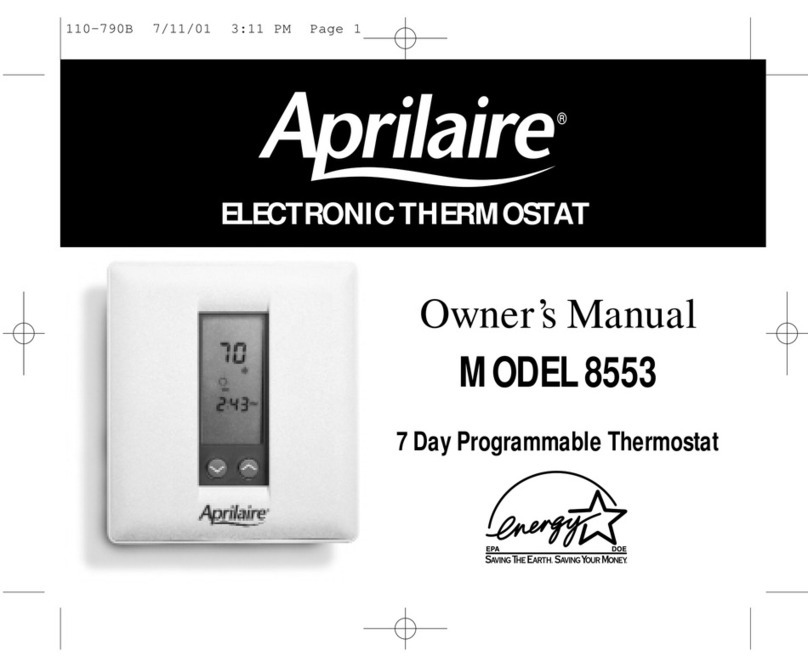
Aprilaire
Aprilaire 8553 owner's manual

Peco
Peco WAVE WIRELESS TW205-206 installation instructions
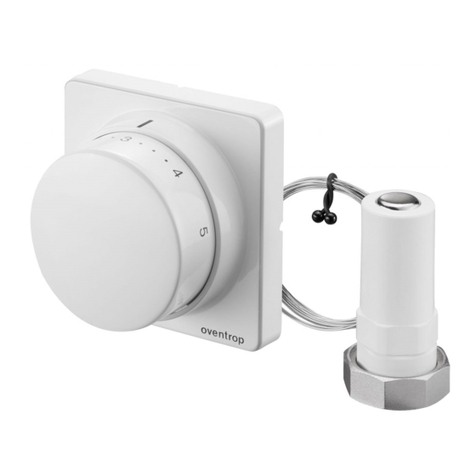
oventrop
oventrop Uni FHU operating instructions
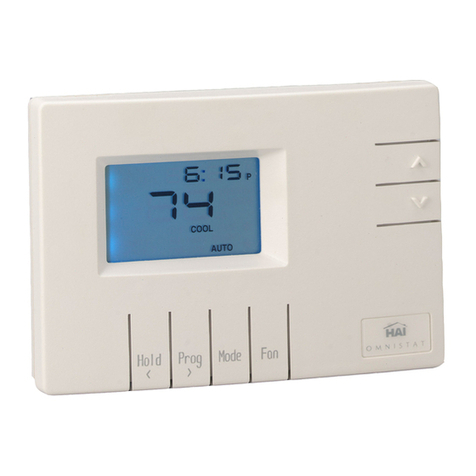
HAI
HAI OMNISTAT RC-112B owner's manual

RS PRO
RS PRO CC908WHB-3 Assembly, installation and operation instructions
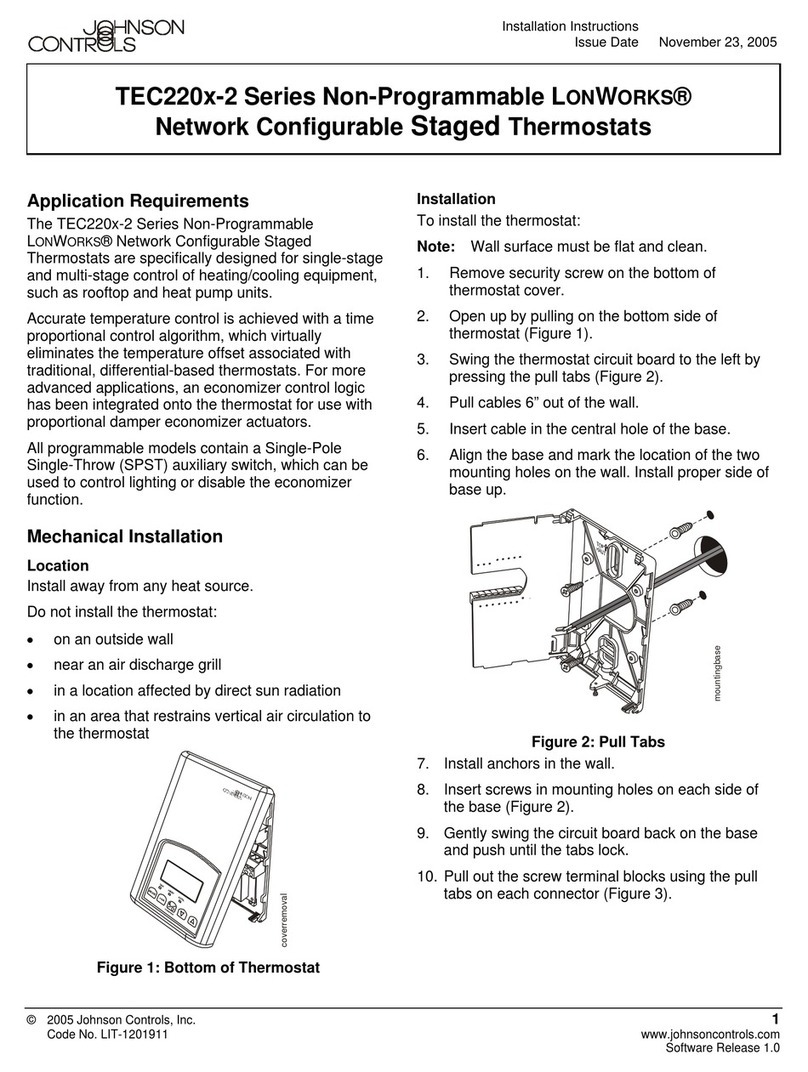
Johnson Controls
Johnson Controls TEC2201-2 installation instructions

Aprilaire
Aprilaire 8870 installation instructions

Honeywell
Honeywell Lyric Round TH8732WFH-5002/U Professional install guide

Mapei
Mapei Mapeheat Thermo Touch installation guide

Carrier
Carrier TP-WEM01 Advanced installation and configuration instrucrions
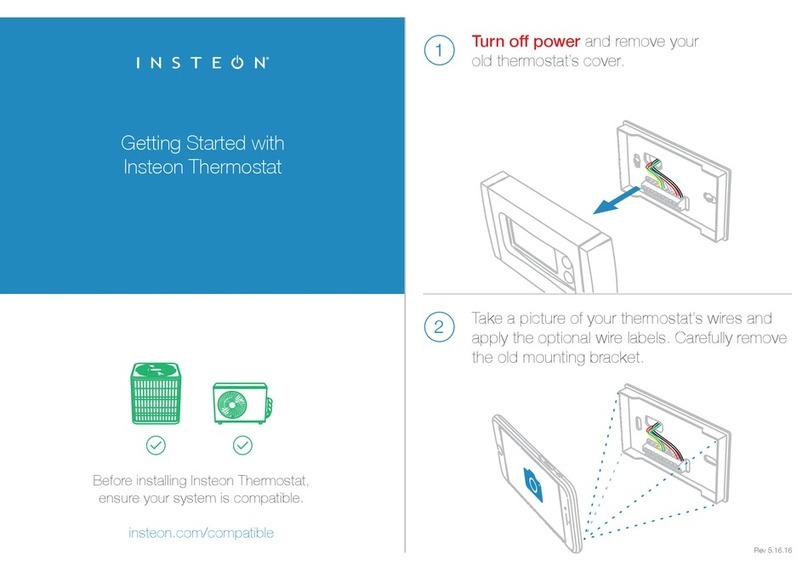
INSTEON
INSTEON TempLinc 2441TH Getting started

ORBRY
ORBRY OBUHTOUCH Easy setup guide

